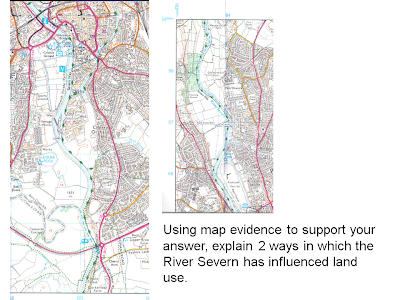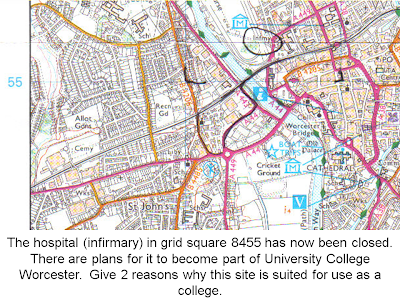Waves: The size of a wave depends on its fetch. The fetch is the distance a wave travels. The greater the fetch, the larger the wave. Wind also has a significant effect on the size of waves. The stronger the wind the larger the wave.
As a wave approaches a beach it slows. This is the result of friction between the water and the beach. This causes a wave to break.
There are two main types of wave. These are
constructive and
destructive waves. :
Constructive waves build beaches. Each wave is low. As the wave breaks it carries material up the beach in its swash. The beach material will then be deposited as the backwash soaks into the sand or slowly drains away. These waves are most common in summer.
Destructive waves destroy beaches. The waves are usually very high and very frequent. The back wash has less time to soak into the sand. As waves continue to hit the beach there is more running water to transport the material out to sea. these waves are most common in winter.
Coastal Processes:There are three main processes at work in the sea. These are
erosion,
transportation and
deposition.
Erosion:Erosion is destructive waves wearing away the coast.
There are four main processes which cause coastal erosion. These are corrasion/abrasion, hydraulic action, attrition and corrosion/solution.
Corrasion/abrasion is when waves pick up beach material (e.g. pebbles) and hurl them at the base of a cliff.
When waves hit the base of a cliff air is compressed into cracks. When the wave retreats the air rushes out of the gap. Often this causes cliff material to break away. This process is known as
hydraulic action.
Attrition is when waves cause rocks and pebbles to bump into each other and break up.
Corrosion/solution is when certain types of cliff erode as a result of weak acids in the sea.
Transportation:Transportation is the movement of material in the sea and along the coast by waves. The movement of material along the coast is called
longshore drift.
Longshore Drift:Longshore drift happens when waves moves towards the coast at an angle. The swash (waves moving up the beach) carries material up and along the beach. The backwash carries material back down the beach at right angles. This is the result of gravity. This process slowly moves material along the beach.
Longshore drift provides a link between erosion and deposition. Material in one place is eroded, transported then deposited elsewhere.
Transportation:Although longshore drift is the main process of transportation the material moves in four different ways. These are:
Traction - large material is rolled along the sea floor.
Saltation - beach material is bounced along the sea floor.
Suspension - beach material is suspended and carried by the waves. .
Solution - material is disolved and carried by the water.
Deposition:Deposition is when eroded material is dropped by constructive waves. It happens because wave have less energy. Deposition creates a range of landforms.
Bays and headlands:Headlands form along coastlines in which bands of soft and hard rock outcrop at right angles to the coastline. Due to the different nature of the rock erosion occurs at different rates. Less resistant rock (e.g. boulder clay) erodes more rapidly than less resistant rock (e.g. chalk).
Erosion of a headland:A headland is an area of hard rock which sticks out into the sea. Headlands form in areas of alternating hard and soft rock. Where the soft rock erodes bays are formed either side of the headland. As the headland becomes more exposed to the wind and waves the rate of its erosion increases. When headlands erode they create distinct features such as caves, arches, stacks and stumps.
The formation of a stack:Stage 1
Waves attack a weakness in the headland.
Stage 2
A cave is formed.
Stage 3
Eventually the cave erodes through the headland to form an arch.
Stage 4
The roof of the arch collapses leaving a column of rock called a stack.
Stage 5
The stack collapses leaving a stump.
Coastal Deposition is when the sea drops or deposits material. This can include sand, sediment and shingle.
Beaches:The beach is the area between the lowest spring tide level and the point reached by the storm waves in the highest tides. Every beach is different but they are usually made up of material deposited on a wave-cut platform.
Spit:Longshore drift moves material along a coastline. Where there is an obstruction or the power of the waves is reduced the material is deposited. Where rivers or estuaries meet the sea deposition often occurs. The sediment which is deposited usually builds up over the years to form a long ridge of material (usually sand or shingle). Such a ridge is called a spit. Spurn Head on the Holderness Coast is an example of this feature.
Why defend the coast?There are a number of reasons for protecting the coast. Coastlines tend to be very heavily populated. They are areas of high economic value due to tourism. Coastlines are particularly prone to flooding. Finally, they are fragile ecosystems which take a long time to recover if they are destroyed.
Hard Engineering:Hard engineering approaches tend to be expensive, last only a short amount of time, are visually unattractive and unsustainable. They often increase erosion in other places further down the coast.
Hard Engineering Techniques:GroynesGroynes are wooden barriers constructed at right angles to
the beach to retain material. Material is trapped between these groynes and cannot be transported away by longshore drift. Groynes encourage a wide beach which helps absorb energy from waves, reducing the rate of cliff erosion. Cheap, retain wide sandy beaches and do not affect access to the beach. Beaches to the south of the defences are starved of beach material due to their affect on long shore drift. £7000 each
Sea WallsSea walls are usually built along the front of cliffs, often to protect settlements. They are often recurved which means waves are reflected back on themselves. This can cause the erosion of material at the base of the sea wall. Provide excellent defence where wave energy is high, reassures the public and long life span. Expensive, can affect beach access, recurved sea walls can increase the erosion of beach material. £3000-4000/m
ReventmentsTraditionally these have been wooden slatted barriers constructed towards the rear of beaches to protect the base of cliffs. Energy from waves is dissipated by them breaking against the reventments. In recent times concrete reventments such as accropodes have been used in places such as Scarborough. Less beach material is eroded compared to a sea wall. Cheaper and less intrusive than a sea wall. Short life span and unsuitable where wave energy is high. £2000/m
Rock armour / boulder barriers
These are often large boulders placed along the base of a cliff to absorb energy from waves. Cheap and efficient. Unattractive, dangerous access to beach, costs increase when rock is imported. £3000/m
GabionsThis is where rocks and boulders are encased in wired mesh. They absorb the energy from waves. Cheap and efficient. Shorter life span than a sea wall. Visually unattractive. £100/m
Off-shore breakwater These are large concrete blocks and boulders located off shore to change the direction of waves and reduce longshore drift. They also help absorb wave energy. Beaches retain natural appearance. Difficult to maintain, unattractive, does not protect the cliffs directly and does not stop beach material from being eroded.
Soft Engineering:Soft engineering approaches are less expensive, are more long term, attractive and sustainable as they work with natural processes.
Soft Engineering Techniques:Beach nourishmentBeaches are made higher and wider by importing sand and shingle to an area affected by longshore drift. Cheap, retains the natural appearance of the beach and preserves the natural appearance of the beach. Off shore dredging of sand and shingle increases erosion in other areas and affects the ecosystem. Large storms will require beach replenishment, increasing costs. £20 /cu.m
Managed retreat:This is when areas of coast are allowed to erode. This is usually in areas where the land is of low value. Managed retreat retains the natural balance of the coastal system. Eroded material encourages the development of beaches and salt marshes. People lose their livelihood e.g. farmers. These people will need to be compensated.

















































